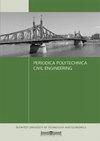水平荷载作用下钢筋混凝土等效框架现浇平板的有限元分析
IF 1.4
4区 工程技术
Q3 ENGINEERING, CIVIL
引用次数: 0
摘要
在结构施工实践中,由于其结构和经济上的优势,钢筋混凝土板的使用极为普遍。一个重要的问题是研究水平效应下的结构行为。其意义不仅集中在风荷载和建筑荷载引起的尺度上,这些尺度被认为是“正常”的,即准静态的,本质上是单向单调增加的,而且研究最多的地震,即周期变化,方向和震级效应。最普遍的确定平板板的单向准静态水平荷载的方法是所谓的等效框架法和有效梁宽度法。除了分析的和基本线性的数值理论方法外,还进行了一些实验室实验并发表。本文采用一种先进的非线性数值模拟方法,研究了柱支撑平板在单向单调增加水平荷载作用下的性能。利用ATENA 3D三维非线性有限元软件建立不同几何尺寸的数值模型。在数值研究中,除了考虑整体意义上的竖向荷载外,还考虑了水平荷载。在我们的研究中,我们分析了结构的整体行为,裂纹扩展和内应力。结果用力-位移图表示,并与实验室实验结果进行了比较,从而显示了数值模拟过程的准确性和局限性。并将数值计算结果与等效框架模型计算结果进行了比较。本文章由计算机程序翻译,如有差异,请以英文原文为准。
Finite Element Analyses of Cast-in-situ RC Flat Slab with an Equivalent Frame for Horizontal Loads
In structural construction practice, the use of reinforced concrete slabs is extremely common due to their structural and economic advantages. An important issue is the study of structural behavior given to horizontal effects. The significance of this is centered not only on the scales caused by wind and construction loads, which are considered to be “normal” i.e., the quasi-static, which is essentially one-way monotonically increasing but also the most researched seismic, i.e., cyclically varying, direction and magnitude effects. The most widespread methods for sizing flat plate slabs to unidirectional, quasi-static horizontal loads are the so-called Equivalent Frame Method and the Effective Beam Width Method. In addition to analytical and basically linear numerical theoretical methods, several laboratory experiments have been performed and published. In this paper, we investigate the behavior of column-supported flat plate slabs against unidirectional, monotonically increasing horizontal loads using an advanced nonlinear numerical modeling method. Numerical models constructed with different geometric dimensions were created with ATENA 3D three-dimensional nonlinear finite element software. In the numerical studies, in addition to the vertical loads in the global sense, the horizontal loads were also taken into account. In our studies, we analyzed the global behavior of the structure, crack propagation, and internal stresses. The results were illustrated on force - displacement diagrams and compared with the results of the laboratory experiments used, thus showing the accuracy and limitations of the numerical modeling procedure. The numerical results were also compared with the results determined on the basis of the equivalent framework models.
求助全文
通过发布文献求助,成功后即可免费获取论文全文。
去求助
来源期刊

Periodica Polytechnica-Civil Engineering
工程技术-工程:土木
CiteScore
3.40
自引率
16.70%
发文量
89
审稿时长
12 months
期刊介绍:
Periodica Polytechnica Civil Engineering is a peer reviewed scientific journal published by the Faculty of Civil Engineering of the Budapest University of Technology and Economics. It was founded in 1957. Publication frequency: quarterly.
Periodica Polytechnica Civil Engineering publishes both research and application oriented papers, in the area of civil engineering.
The main scope of the journal is to publish original research articles in the wide field of civil engineering, including geodesy and surveying, construction materials and engineering geology, photogrammetry and geoinformatics, geotechnics, structural engineering, architectural engineering, structural mechanics, highway and railway engineering, hydraulic and water resources engineering, sanitary and environmental engineering, engineering optimisation and history of civil engineering. The journal is abstracted by several international databases, see the main page.
 求助内容:
求助内容: 应助结果提醒方式:
应助结果提醒方式:


